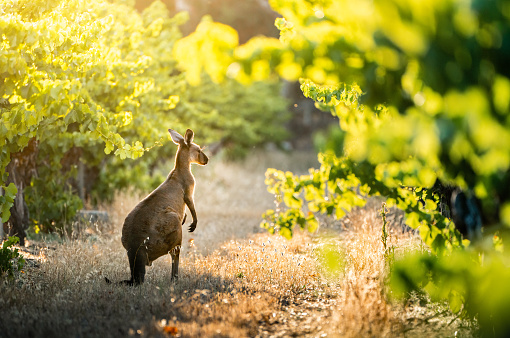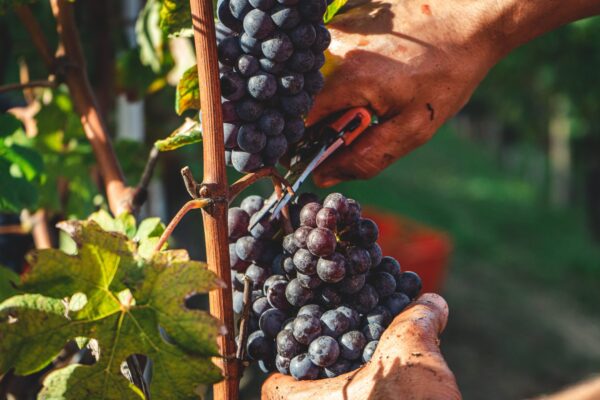Take a trip to the other side of the world with us to the wine region of Australia. Everyone is familiar with Australia with its enormous land area of 7.7 million sq. kilometers or nearly 15 times the total area of France. Its vineyards, however, cover about 160,000 hectares (395, 000 acres), compared to 800,000 hectares for France (1.9 million acres). And yet with a production of over 10 million hectolitres of wine a year, Australia ranks within the top ten biggest wine producing countries. Depending on the year, it occupies the fifth or sixth place, competing closely with Argentina.
Birth of Australian Winegrowing
Vines first appeared in the country in 1788, in the Sydney area where they had been brought by English emigrants. Vineyards quickly developed in the areas best suited to winegrowing, which tended to be inland. In 1870, vines were planted in all of Australia’s states, but unfortunately many succumbed to the infamous phylloxera.
Australian Grape Varieties
So what grape varieties are used Down Under? They are mostly identical to those used in France. For white wines, you find Chardonnay, Riesling, Semillon, Sauvignon, Verdelho (a Portuguese variety), Marsanne and Viognier. For reds, you of course have the famous Syrah grape, known here as Shiraz, and since 1832, Cabernet Sauvignon, Merlot, Grenache and Pinot Noir have also been grown in Oz.
The Seven Main Australian Wine Regions
Western Australia
This is the state with the largest area of vineyards, most of which are located in its southern part. Western Australia has a broad range of climates – for example, you can find a very hot climate in Swan Valley and a much cooler one south of Perth.
Northern Territory
In this large state, vineyards are rare. There are actually more crocodiles than vines here! More seriously though, the state is in fact home to the well-known wine region of Alice Springs.
South Australia
This is one of the largest wine producing states of Australia. It is also home to a number of world-famous and highly reputed geographical indications or regions, like Barossa Valley and Eden Valley, near Adelaide.
Queensland
Vineyards are scarce in this part of Australia, with most located in the south-easterly part of the state near Brisbane. Queensland has just two appellations or official wine regions: Granite Belt and South Burnett. Grape harvesting is said to be done at night in some cases, to have cooler grapes and to improve fermentation.
New South Wales
This state is in the south east of Australia where summer is scorching and autumn damp. It is here that we find the famous Hunter Valley, considered to be the birthplace of Australian winegrowing. However, there are a number of other just as prestigious regions in New South Wales, such as Mudgee, Cowra, Hasting River, Riverina or Orange.
Victoria
This was the largest producing wine region in the 19th century but fell victim to phylloxera in 1877. It wasn’t until the 1960s that the wine region began to shine again. A cool climate, low rainfall and volcanic soils are some of the distinctive features of this zone.
Tasmania
The first vineyard was founded in this region in 1823. Winegrowing then all but disappeared for nearly a century until 1950. Being an island, Tasmania has an unusual climate compared to Australia’s other states that can be described as a “European” climate. It is a cool climate which is why many sparkling wines are made in this region, from Chardonnay and Pinot Noir.
Australian wine production
For reasons of climate, most of Australia’s wine is produced in the south of Australia, near Sydney, Perth and Adelaide. Unlike in France, the wine harvesting season starts in late January around Perth and finishes in May in the region of Victoria.
Thanks to Australia’s many climates, soils and hill ranges, it offers a complete range of wine styles, including still wines, fortified wines and sparkling wines. In Barossa Valley, the climate is very hot and dry. During harvest, temperatures regularly attain 40°C. It a relatively hilly region with altitudes varying between 230 and 550 metres above sea level. Such variations in terrain provide the wide ranging soils and climates that are the strength of this country in the southern hemisphere and that enable it to produce an interesting array of wines.
Barossa Valley Woodcutter’s Shiraz Domaine Torbreck
D-Vine has featured this Barossa Valley wine from Domaine Torbreck on its wine list for several years now. Barossa Valley is a highly reputed Australian wine region, located 60 kilometers north-west of Adelaide and producing extremely rich wines. David Powell founded the Torbreck wine estate in 1994, drawing inspiration from the wines of the Rhone Valley, which is famously the home of his favourite grape, Syrah (or Shiraz). Since 2008, Pete Kight has owned the estate. He continues to champion excellence and expertise making Torbreck one of Barossa’s top estates.
This 100% Shiraz has everything, with its deliciously rich and opulent style. Woodcutter’s Shiraz is a characterful wine displaying notes of roast coffee and black fruits, guaranteeing a fantastic voyage of flavour.
Learn more
After Australia, come with us to discover the wine region of Argentina, where wine has been grown for more than 500 years, since the arrival of the first Spanish colonizers in South America. Read the article



